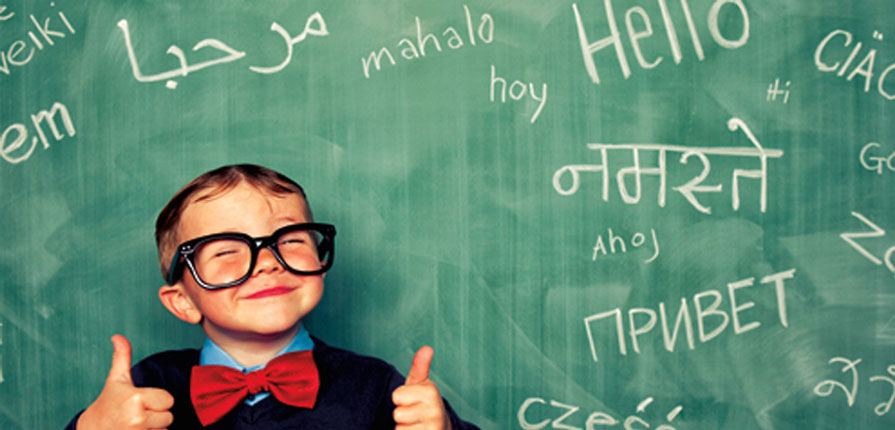– but it cannot learn languages attending language classes once a week
Back when I was a cheeky 14-or-so-year-old, I taught my mom how to say this English sentence: I am an old and ugly witch! She didn’t have a higher education, but at the age of almost 50, when most of the childbearing and caregiving was over and done with, she had decided that she wanted to learn English at a Danish evening school. Apparently, I wanted to help her out a little, and so I taught her the abovementioned phrase. Of course, I told her that it meant something completely different than what it actually does, and I succeeded in my deception, despite the fact that she had already completed a few years of English evening school classes. As overbearing as my dear mother was when I played pranks on her, she was still just as bad at English. Why?

Children are amazing when it comes to learning languages, but adults have a difficult time doing so. These are universally known truths, and they have led to the hypothesis that at some point in childhood, a change/maturation of the brain happens that prevents us from accessing the same mechanisms we used for learning our native language at a young age. Therefore, it is difficult to learn new languages as an adult. This is called the critical period hypothesis of second language acquisition, referencing the period of childhood where the brain is geared towards learning language.
However “universally known truths” are often half-truths, and sometimes they are not truths at all. It is true that people who have learned a second language in childhood typically speak and comprehend it more proficiently than people who have learned a second language as adults. All other things being equal, children have the upper hand in becoming proficient in a second language. But wait a minute, try reading the previous sentence again. No really, read it again! The words “other things being equal” might not seem like the most critical part of the sentence, but in an empirical study they would be considered a fundamental premise for drawing any conclusions. There is a big difference between these two sentences: 1) Children are better at learning a second language. 2) All other things being equal, children are better at learning a second language. Number 1) is definitely a general truth, but also not very interesting. Number 2) is a scientific hypothesis that can be put to the test. If children are better at learning a second language all other things being equal, it suggests an age-dependent biological or psychological difference between children and adults concerning the possibility for second language acquisition; a critical period for second language acquisition in childhood so to speak. But in existing empirical comparisons of second language acquisition among children and adults, the two groups do not just differ in age. They differ in a wide range of factors related to second language acquisition. Therefore, it can’t be established with certainty that children all other things being equal are better at second language acquisition. In the following, I’ll take a look at two important differences between children and adults that can influence how well they acquire a second language.
Children and adults do not get the same linguistic input
It is well documented that children’s acquisition of their native language is heavily influenced by their linguistic environment, i.e. how much language they listen to, and how much they are spoken to. This is, naturally, also true for a second language. And who listens to and uses a second language the most, we might ask ourselves? 1) An immigrant child who moved to a different country and spends half their day in a childcare institution or school and maybe also uses the second language in their free time or 2) my mom who took English classes at an evening school once a week for maybe 30 weeks a year? Taking a wild guess, the immigrant child probably listens to 100 times more words, sentences and sounds in their second language than my mom did. And the mentioned input essentially makes up the building blocks used to construct the second language. If we instead compare the hypothetical immigrant child with its parents instead of evening school attendees, there will typically also be differences in the extent of second language use. Children dive in head first and are not afraid of failing. The adult parents are less keen on sounding imperfect or maybe even afraid of sounding “childish”, and thus do not delve into using the second language in the same way. But practice makes perfect. Simple as that. So, adults and children learning a second language aren’t “equal” when it comes to quantitative input and use of the second language.
Transfer: One language affects the other

The native language is another area where children and adults are not equal, more specifically when it comes to how neurologically rooted the native language is when you start learning a second language. The researcher François Grosjean published a research article with the striking title: Neurolinguists, beware! The bilingual is not two monolinguals in one person. There are no “perfect” bilinguals in the sense that they speak both languages in exactly the same way as a monolingual can. Besides the fact that, all other things being equal, bilinguals speak each language less than they would have done as monolinguals, it is also impossible for them to keep the languages completely separated. Elements from one language sneak up on you while you are using the other – so-called ‘interference’ or ‘transfer’. What is usually considered first when it comes to transfer is a native language’s influence on a second language. The sounds from the native language are used as a starting point for speaking the second language, which results in a foreign accent. Furthermore, sentence structures from the native language are carried over to the second language where they are either wrong or just sound a little odd. The more neurologically rooted the native language is, the harder it is to change the neural networks to favor the second language, and the more the native language will be affected by the second language.
The native language is not as rooted in children, so they can more easily “make room” for the second language. But this also means that they will simultaneously become worse at their native language! Transfer goes both ways. My family and I spent a few years in Alabama, and when my daughters had become proficient in English, I caught them saying things like “Jeg fortæller på dig” (i.e. “I’m telling on you”) or “Der er ingen der må bruge min fløjte men mig!” (i.e. “No one can use my whistle but me”). Both sentences are direct translations of English phrases that don’t quite work in Danish. In other words, the sentence structures are transferred from the second language to the native language. My daughters’ Danish pronunciation was also Americanized. This can happen to adults too. I have an old friend from Denmark who moved to Norway as a young adult and has lived there for around 20 years. Her Danish is regularly affected by Norwegian: For instance, when saying “I want…”, she will say “Jeg har lyst på…” (instead of the Danish “jeg har lyst til” ); she uses the word “må” (“must”), when Danes would typically use “skal” (“should”); she replaces the Danish “løbebånd” (“treadmill”, literally ‘running band’) with the Norwegian “trædemølle” (literally ‘treading mill’); and she pronounces p, t, and k more powerfully than what is typical in Danish. These are a natural consequence of having acquired great proficiency in a second language, both in children and adults. You simply can’t be two monolinguals in one person. But it presumably takes longer for adults before the second language starts to affect the first language. So, when children learn a second language better than adults, it is at the expense of the native language to a higher degree than it is for adults.
Is there a critical period for language acquisition?
But if adults were given exactly the same conditions as children for learning a second language, what would happens? This is a very difficult question to answer because such an experiment would require some adults to move to another country and heavily reduce their use of their native language while learning a second language by listening to and acoustically analyzing the sounds of the new language without understanding them. In this way, they would slowly infer the structure and the rules just by listening to and analyzing the massive amounts of linguistic input they would get on a daily basis. Such an experiment would be virtually impossible to conduct (Any volunteers?). But it is possible to statistically control for some of the variables that distinguish children and adults apart from chronological age, e.g. the degree to which the second language is used, how long they have used it etc. When this is done, it is still shown that children have an advantage over adults. Is this not evidence for a critical period for second language acquisition?
No, it is not, in my opinion. To claim a critical period is to claim a significant change in the ability to learn languages at some point during childhood, as well as a categorical difference between the capabilities of children and adults when it comes to language acquisition. But their capabilities do not seem to be categorically different. The main takeaway from the scientific literature is that people become worse at second language acquisition as they age, beginning in the earliest years, but simultaneously they also retain their native language more firmly. How much each language is used and how long an individual has spoken a second language is also of significance, but it does not give us the entire explanation. In other, non-linguistic cognitive areas, age is also a factor, e.g. learning a new instrument. Your age when you start playing the piano has both neural and competence-related effects that are comparable to the age effects on language. Yet, nobody is claiming that we have a biologically programmed window for learning to play the piano that has arisen through evolution! The most likely scenario is that both language and piano playing (among other things) draw on general cognitive and motor skills that gradually become less flexible with age, but nevertheless do not disappear.
Anders Højen is associate professor of linguistics at Trygfonden’s Centre for Child Research at Aarhus University. He is also an author of children’s books.
This post was translated from Danish by Hannah Fedder Williams.
Read more:
Højen, A. (2019). Predictors of bilinguals’ speaking rates. Journal of Phonetics, 77, 100936. doi:/10.1016/j.wocn.2019.100936
Meulman, N., Wieling, M., Sprenger, S. A., Stowe, L. A., & Schmid, M. S. (2015). Age effects in L2 grammar processing as revealed by ERPs and how (not) to study them. PloS One, 10(12), e0143328. doi:10.1371/journal.pone.0143328
Singleton, D. (2005). The Critical Period Hypothesis: A coat of many colours. In International Review of Applied Linguistics in Language Teaching (Vol. 43, pp. 269).
Vaquero, L., Hartmann, K., Ripolles, P., Rojo, N., Sierpowska, J., Francois, C., . . . Altenmuller, E. (2016). Structural neuroplasticity in expert pianists depends on the age of musical training onset. Neuroimage, 126, 106-119. doi:10.1016/j.neuroimage.2015.11.008
Watanabe, D., Savion-Lemieux, T., & Penhune, V. B. (2007). The effect of early musical training on adult motor performance: evidence for a sensitive period in motor learning. Experimental Brain Research, 176(2), 332-340. doi:10.1007/s00221-006-0619-z






